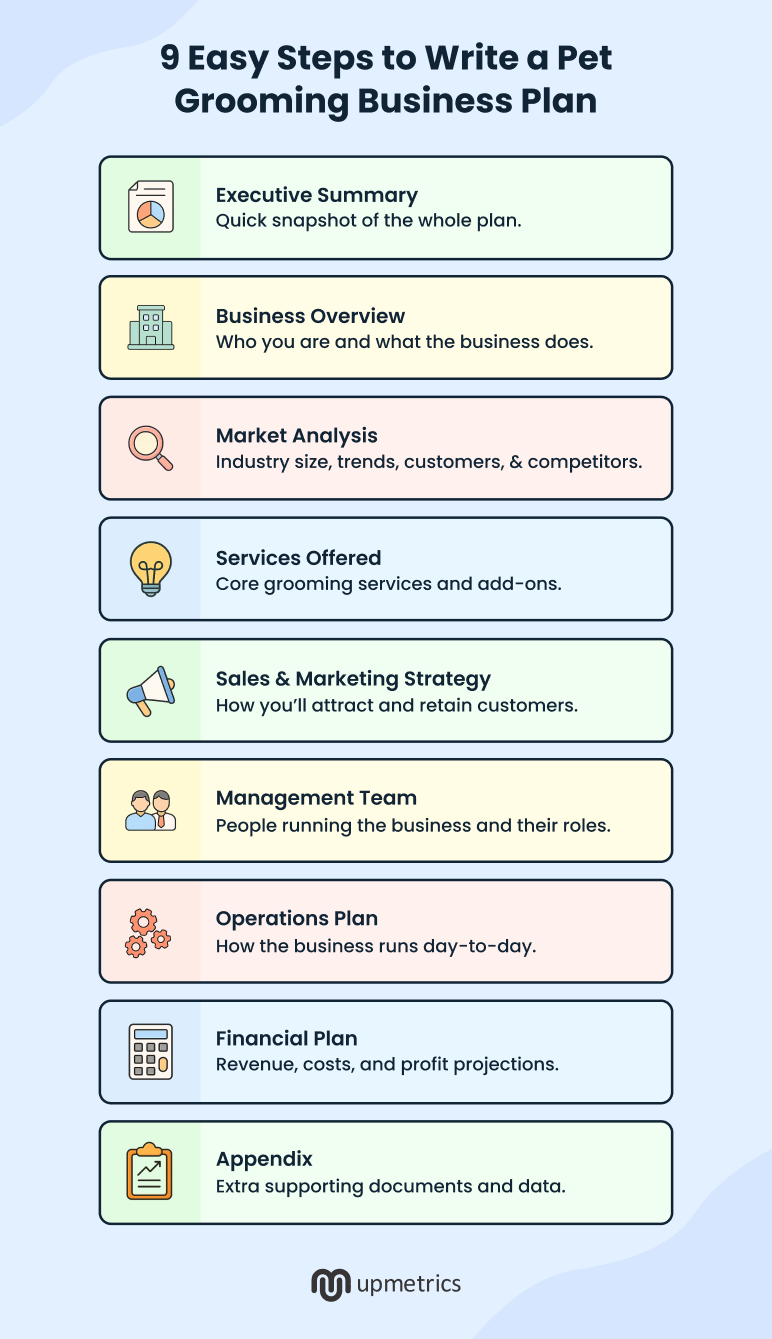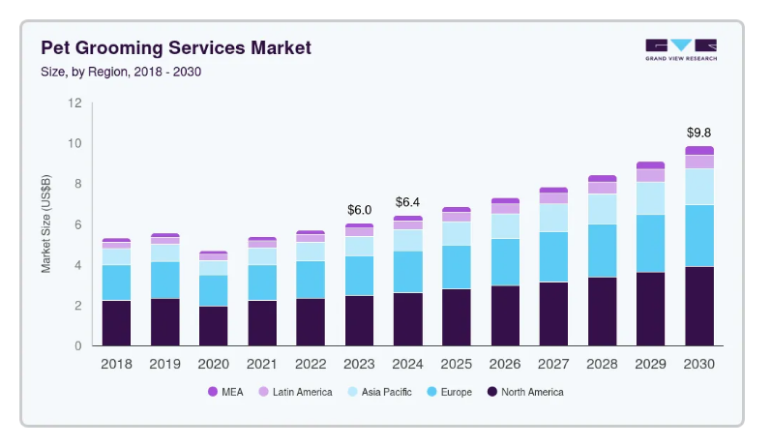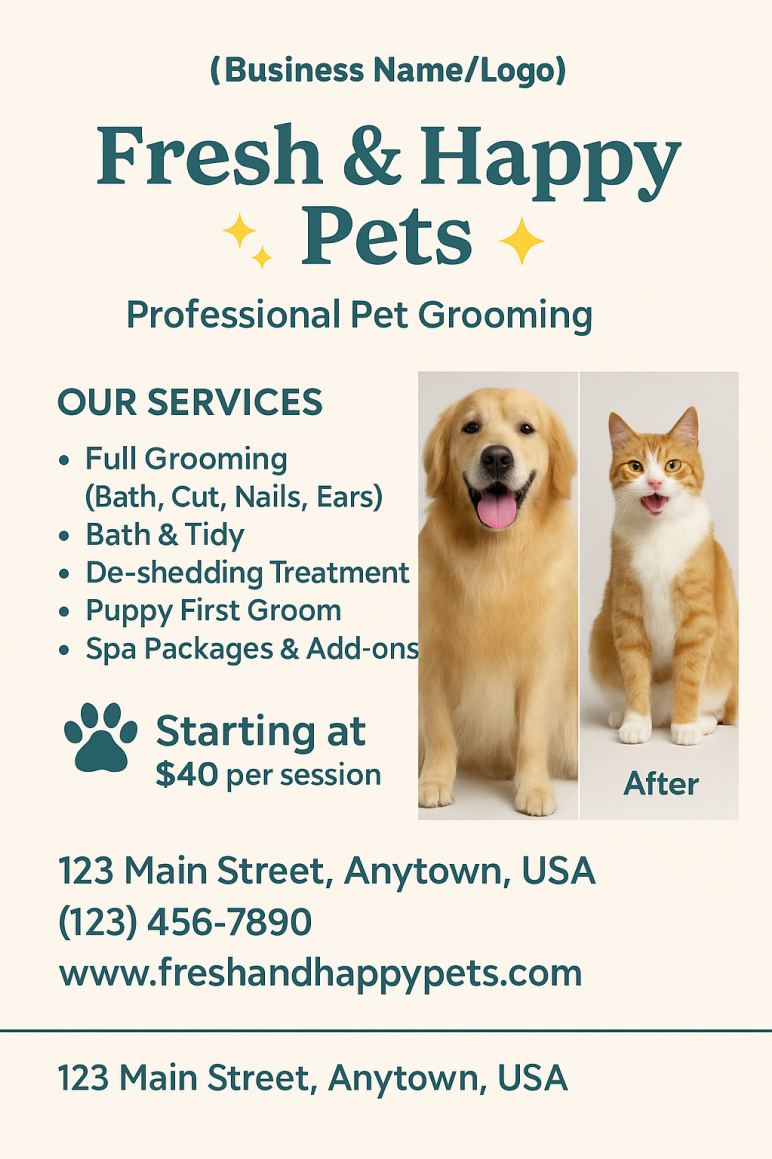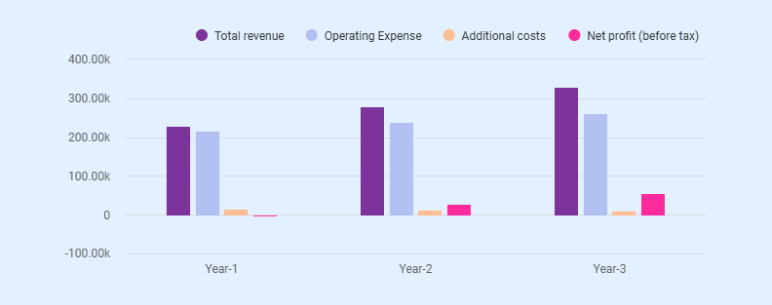Pet grooming is a growing industry with strong demand, but competition can be tough. Customers expect quality care, trust, and consistent service.
A simple outline might not be enough—you need a complete plan to ensure you’re covering the essentials, from market research to pricing, operations, and customer retention.
That’s why we’ve built this template considering all the operational needs, licensing requirements, local competition, and customer expectations in the pet care sector.
Download this pet grooming business plan template; it has everything you need to write a professional, investor-ready plan.
Keep reading for help using the template or writing a plan from scratch.
How to write a pet grooming business plan?
Writing a pet grooming business plan doesn’t have to be complex. You just need to clearly explain what your business does, how it’ll run, who it serves, and how you plan to make money.
Follow these 9 easy steps to build a plan that works:

1. Executive Summary
The executive summary is a concise, clear summary of your entire pet grooming business plan.
While it appears at the beginning of your plan, you’ll want to write it last (after you have completed all the other sections). This ensures you already have all the details in place, making it easier to highlight only the most important points.
Think of it as your business’s “first impression” on paper. If it’s the only section a reader looks at, they should know what your business is, how it’ll operate, and why it has a strong chance of being successful!
Your executive summary should cover the important points of your pet grooming business in a few short paragraphs:
- Business concept
- Location & ownership
- Business goals
- Target market
- Unique selling proposition
- Financial highlights
Keep this section brief and engaging—ideally one page or less. The aim is to get the reader interested enough to keep reading the rest of your plan.
Be confident, but realistic. If a potential investor or partner reads your executive summary, they should walk away with a clear understanding of your grooming business and why it’s positioned to succeed.
Say goodbye to boring templates
Build your business plan faster and easier with AI
Plans starting from $14/month

2. Business Overview
The business description provides an in-depth overview of your pet grooming business and its foundation. It’s where you identify who you are and what you do, and by completing it, you’re describing the structure of your business.
While planning this section, consider highlighting the key details that define your pet grooming business, such as:
- Company overview: List your business name and location (storefront, mobile grooming unit, or home-based).
- Mission and vision: Add a mission that briefly defines your purpose and a vision that shares a long-term outcome.
- History and stage: Explain why you started the business and any early milestones (e.g., grooming experience, certifications, customer base).
- Services and specialty: Provide a list of your grooming services and highlight any specialties (breed-specific grooming, organic products, or mobile grooming).
- Business structure and team: Describe your company structure and note any partners, groomers, or support staff.
- Goals and objectives: Share short-term goals (like gaining regular clients or breaking even) and long-term goals (such as opening another location or adding spa treatments).
By the end of this section, the reader should have a good understanding of your business identity, stage of business, and direction. It should answer one simple question: “What is this business, and why does it exist?”
3. Market Analysis
The market analysis section explains why starting a pet grooming business makes sense at this time.
Grooming is no longer just an optional service—it’s a part of an industry that is increasingly customer-focused, steadily growing, and full of opportunities for repeat business.
This section summarizes your pet grooming industry facts, growth forecasts, target customers, competitors, and local opportunities relevant to a grooming services.
When writing the market analysis section, it’s important to include the following points:
Industry overview
Show why pet grooming is a real business and not just a side job. You may state: Pet ownership is at an all-time high, and pet owners increasingly treat their pets like family, which drives demand for premium grooming services.
Market size and demand
Next, explain how big the pet grooming industry is and how much it’s expected to grow over time. Adding statistical data from reputable sites makes this clearer. For example:
“The global pet grooming services market size was estimated at $6.89 billion in 2024 and is projected to reach $134.71 billion by 2030, growing at a CAGR of 7.33% from 2025 to 2030.”
You may even consider including charts that clearly illustrate the projected growth of the global pet grooming services market by region. For instance:

This will help you showcase that the continued focus on the pet industry is a direct result of more adoption of pets, increased disposable income, and the investment in the health and appearance of their pets.
Target customers
Describe the key groups of customers for grooming services:
- Busy professionals who want quick, reliable grooming.
- Families with multiple pets are looking for affordable care.
- Owners are willing to pay for premium or specialty services.
- Seniors or homebound owners who prefer mobile grooming.
Competitive analysis
Check who else is offering pet grooming services in your area. Start with direct competitors, like local grooming salons and mobile groomers, and then look at indirect ones, like vet clinics or pet stores that provide grooming.
Note the services they offer, their pricing, and the type of customers they attract.
You can also do a simple SWOT analysis to compare strengths, weaknesses, opportunities, and risks. This will even help you identify gaps in the market, such as long wait times, limited specialty services, or a lack of mobile options.
Market trends
Summarize the trends shaping the grooming market:
- Mobile vans and at-home grooming are rising for convenience.
- More demand for eco-friendly and hypoallergenic products.
- Online booking and loyalty apps are becoming common.
- Spa treatments, creative styles, and breed-specific cuts are gaining popularity.
Local market insight
Identify local opportunities in your area, such as neighborhoods with a high number of pet owners and low competition, or direct demand for certain specialized grooming (certain dog breeds/cats, etc.).
You may also include gaps such as new residential developments with no grooming shop, or places where busy pet owners prefer mobile services.
By clearly covering these elements, you clearly show investors, lenders, and partners that you understand where the market for pet grooming is moving and exactly how your business will capture its share.
4. Services Offered
This section explains the core grooming services you’ll provide, why they matter to pet owners, how you stand out from competitors, and how you plan to grow your business offerings.
Start with the core grooming services, as these are the base of the business and the ones most customers book.
The table below helps you outline the core grooming services, what’s included in each, and the average price range. This makes it easy for readers to see how the offerings meet different pet care needs.
| Services | What’s included | Average price |
|---|---|---|
| Full-service grooming | Bath, haircut, styling, nails, ears, brushing | $60–$100 |
| Bath & tidy | Wash, blow-dry, light trim, paw cleaning | $40–$65 |
| De-shedding treatment | Special brushing, de-shedding tools, and coat conditioning | $25–$50 |
| Puppy/kittens’ first groom | Gentle bath, nail trim, short grooming session | $30–$50 |
| Spa package add-on | Conditioning mask, paw balm, aromatherapy | +$15–$25 |
If you plan to sell retail products alongside grooming services, mention them here:
- Pet shampoos, conditioners, and grooming brushes.
- Collars, leashes, bows, and bandanas.
- Pet dental chews and healthy treats.
These not only generate extra revenue but also reinforce your position as a trusted pet care provider.
After that, show how you’ll maintain high standards in every service:
- Using pet-safe, vet-approved products.
- Follow strict cleaning and sanitation protocols for tools and equipment.
- Tailoring each groom to breed-specific standards or customer preferences.
- Keeping pets calm through gentle handling and stress-free techniques.
By clearly laying out your services, add-ons, retail offerings, and quality standards, you prove that your grooming business will meet customer expectations, encourage repeat visits, and stand out in a competitive pet care market.
5. Sales and Marketing Strategies
Having great grooming services and skilled staff is important—but none of it matters if pet owners don’t know you exist or aren’t motivated to book an appointment.
This section explains how you’ll make your grooming business visible, attract new customers, and keep them coming back for repeat services.
Marketing strategy
The main goal is to build awareness and trust. Pet owners need to know that the grooming business is nearby, reliable, and worth their time and money.
Some effective strategies include:
- Adding clear, branded signage outside the shop or on a mobile grooming van to draw attention.
- Partnering with local vets, pet stores, and shelters for referrals and cross-promotions.
- Creating a mobile-friendly website with service details, pricing, and an online booking system.
- Setting up a Google Business Profile with photos, reviews, and updated hours.
- Running Facebook or Instagram ads showing before-and-after grooming results, seasonal packages, or promotions.
- Attending community pet events or adoption fairs to showcase services and hand out discount cards.
- A flyer with special offers is a simple way to attract customers, whether it’s discounts for first-time visitors, referral rewards, or seasonal drink deals
Here’s a sample flyer design that you can take as a reference to create your own for promotions and local visibility:

Sales strategy
Once potential customers know about your grooming business, the focus turns to converting them into repeat clients.
This means delivering consistent results, offering fair pricing, and creating a positive experience for both pets and owners. For that, you can:
- Offer special promotions, such as discounts for first-time customers or bundled grooming packages.
- Set up a loyalty program where clients earn a free grooming after every five visits.
- Recommend services tailored to each pet’s needs, such as de-shedding for heavy-coated dogs or summer trims for hot weather.
- Keep scheduling flexible by offering evening and weekend appointment slots.
- Send text or email reminders so clients never miss upcoming or repeat appointments.
- Ask satisfied customers to leave online reviews and share before-and-after photos on social media.
6. Management Team
When investors or partners assess a business plan, they’re considering not only the business but also the people running it.
And as the name suggests, the management team section describes who’s driving the pet grooming services forward and why they’re the best fit for your business’s success.
If you’re the founder, introduce yourself and provide a short background.
If there are co-founders or important team members, you can list them in this section as well. For each team member, include their name, job title, and what their primary responsibilities are to the business.
If you have any support on the outside—such as a mentor in grooming school, a business mentor, or adviser, mention them.
The goal of this section is to show you’re in good hands, since the team (or yourself) understands how to keep the day-to-day operation running smoothly, while building a loyal customer base over time.
7. Operations Plan
The operations plan explains how your pet grooming business will run day to day. While earlier sections focus on what you’re offering, this part shows how you’ll keep everything working behind the scenes.
Here’s what to include in your grooming operations plan:
- Where will you operate from? State if you’ll run a fixed-location salon, a mobile grooming van, or a home-based setup, and where you’ll store grooming tools, products, and supplies.
- What equipment do you need? List grooming tables, bathtubs, dryers, clippers, scissors, brushes, cages, and cleaning tools. If mobile, include water tanks, generators, and climate control systems.
- Who’s running daily operations? Mention if you’ll handle grooming yourself or hire additional groomers, assistants, and reception staff.
- How will you schedule and manage clients? Explain your booking system (online, phone, walk-in) and how you’ll handle reminders, cancellations, and rescheduling.
- How will you maintain tools and facilities? Say how often you’ll clean and sanitize grooming equipment, bathtubs, and work areas.
- How will you ensure safety and quality? Describe your pet handling protocols, breed-standard grooming practices, and customer satisfaction process.
8. Financial Plan
The financial plan is where you turn your pet grooming business ideas into numbers. This section proves the business is financially viable and is especially important for investors or lenders.
Your estimates should cover the next 3–5 years and include the following major components:
Operating expenses
List recurring costs such as grooming supplies, shampoo and conditioners, utilities (water, electricity), payroll, rent or mobile vehicle maintenance, marketing, and booking software.
One-time startup costs
Include expenses such as salon build-out or van conversion, purchase of grooming tables, tubs, dryers, clippers, scissors, branding and signage, licenses, and initial supply inventory.
Revenue estimates
Include your service pricing, the expected number of grooming appointments per day or week, and estimated income from retail product sales.
Break these down by service type (full grooming, bath & tidy, add-ons, etc.) to show realistic earning potential.
Profit and loss statement
Estimate your annual profit or loss based on projected revenue and expenses. This will help determine when your business will break even.
Here’s a sample chart and table showing projected revenue, expenses, and profit/loss for three years. Use this as a reference to create your own.

| Category | Year 1 | Year 2 | Year 3 |
|---|---|---|---|
| Total Revenue | $230,000 | $280,000 | $330,000 |
| Operating Expenses | $216,000 | $240,000 | $263,000 |
| Additional Costs | $15,000 | $13,000 | $11,000 |
| Net Profit (Before Tax) | -$1,000 | $27,000 | $56,000 |
Cash flow forecasts
Show how money will flow into the business from grooming services and product sales, and how it’ll be spent on supplies, wages, rent, marketing, and maintenance.
Balance sheet
Present a complete picture of your financial position by listing assets such as equipment and inventory, along with liabilities and owner equity.
Finally, include your key financial assumptions, such as average appointments per week, average spend per customer, product margins, and customer retention rate. These should align with your overall business plan and help validate your projections.
9. Appendix
The business plan appendix isn’t compulsory to add. But it’s useful for investors, partners, or anyone who wants more details about the grooming business. It includes extra information that supports the plan but doesn’t fit in the main sections.
You can add things like:
- Financial statements (income statement, balance sheet, cash flow forecasts)
- Market research on industry size, customer demographics, and grooming trends
- Licenses, permits, or contracts
- Marketing materials, brochures, or sample promotions
- Operating procedures or staff training details
- Photos of the salon, mobile unit, or grooming setup
- Customer reviews or testimonials
In simple terms, the appendix is like an extra folder. It shows the business is well-prepared and gives more proof without making the main plan too long.
Download a free pet grooming business plan template
Writing a business plan can feel like a big task, especially if it’s your first time. The good news is you don’t have to start from scratch. Use our free pet grooming business plan template to get a head start.
This sample plan is designed for aspiring grooming business owners and includes example sections and financial projections to guide you through each part of your plan. You can even easily customize it to match your business-specific needs.
The Quickest Way to turn a Business Idea into a Business Plan
Fill-in-the-blanks and automatic financials make it easy.
Conclusion
Now that you’ve gone through this detailed guide and a free template, creating your pet grooming business plan should be much simpler.
However, if you want to speed things up even more, try using Upmetrics—a modern, AI-powered business planning tool that helps you build a professional plan in just a few minutes.
With advanced AI capabilities and built-in financial forecasting features, it makes planning quick and stress-free. And if you’re raising funds or pitching to potential partners, you’ll also get a polished pitch deck ready to share.
So why wait? Start your pet grooming business today!



